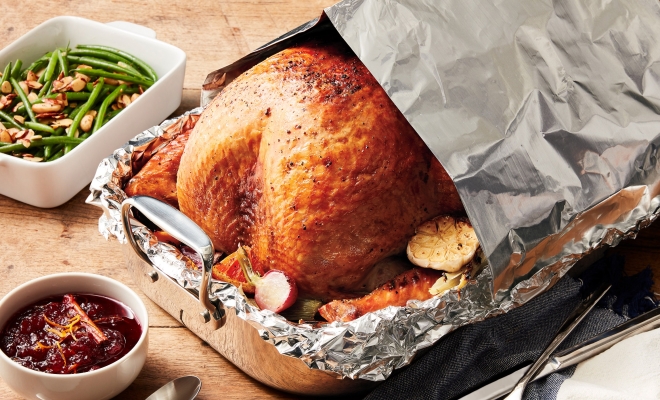Roasting a turkey can be an intimidating process, especially if you’re tackling it for the first time With such a large bird and long cook times, it’s understandable to have questions about the best techniques One common area of confusion is whether or not to cover the turkey in foil while it roasts. Here’s a comprehensive guide on when and how to tent your turkey with foil for the most juicy, flavorful results.
Why Tenting Turkey with Foil Helps
Tenting foil over your roasting turkey serves two main purposes
-
It prevents the turkey skin from over-browning or burning. The foil creates a protective barrier between the hot oven air and the turkey skin This allows you to roast the turkey for hours while avoiding dried out, leathery skin
-
It keeps the turkey moist. The foil traps steam rising from the turkey, essentially braising it from the inside out. This steam reabsorbs into the meat, resulting in a tender, juicy interior.
So in short, foil prevents overcooking on the outside while promoting tender juiciness on the inside. It gives you the best of both worlds.
When Should You Tent the Turkey?
You don’t want to tent the turkey for the entire cook time. Doing so would yield a pale, soggy skin.
The ideal technique is to roast the uncovered turkey for the first 1/3 to 1/2 of the total cook time. This allows the skin to partially crisp and brown, developing flavor.
Then, tent the foil over the turkey for the middle 1/3 to 1/2 of cooking. This prevents further over-browning while sealing in moisture.
For the last 30-60 minutes, remove the foil tent so the skin fully crisps again before serving.
As a general guideline, Butterball suggests tenting the turkey after it has cooked for 2/3 of the total recommended time for its size. This timing method works well for most birds.
How to Create a Foil Tent
Making a foil tent is simple:
-
Use heavy duty aluminum foil, as regular foil may tear. Have about 3 large sheets on hand.
-
Shape the foil loosely over the turkey, leaving some air space between the bird and foil so steam can circulate.
-
Avoid pressing the foil down tightly onto the skin, as this can tear it when removing.
-
Crimp and seal the edges of the foil to the roasting pan to trap moisture.
-
For extra browning, tent just the breast and leave the legs/thighs uncovered. The white meat tends to dry out faster.
-
Remove the tent during the last 30-60 minutes as needed for evenly golden skin.
Other Turkey Roasting Tips
-
Roast the turkey on a V-shaped roasting rack in a pan, to allow airflow underneath.
-
Rub softened butter under and on top of the skin for flavor and moisture. Season the cavity as well.
-
Use an instant-read thermometer to check doneness; breast should reach 165°F.
-
Let the roasted turkey rest tented in foil for 15-20 minutes before carving.
With these foil tenting guidelines, you can look forward to a perfectly bronzed, juicy turkey! Tenting is easy turkey insurance to make sure the bird turns out right on your holiday table.

Tent vs. Wrap: Turkey Tips with Reynolds Wrap® Heavy Duty Aluminum Foil
FAQ
When should I cover my turkey with foil?
Does tenting a turkey slow the cooking time?
How long will a turkey stay warm in foil?
